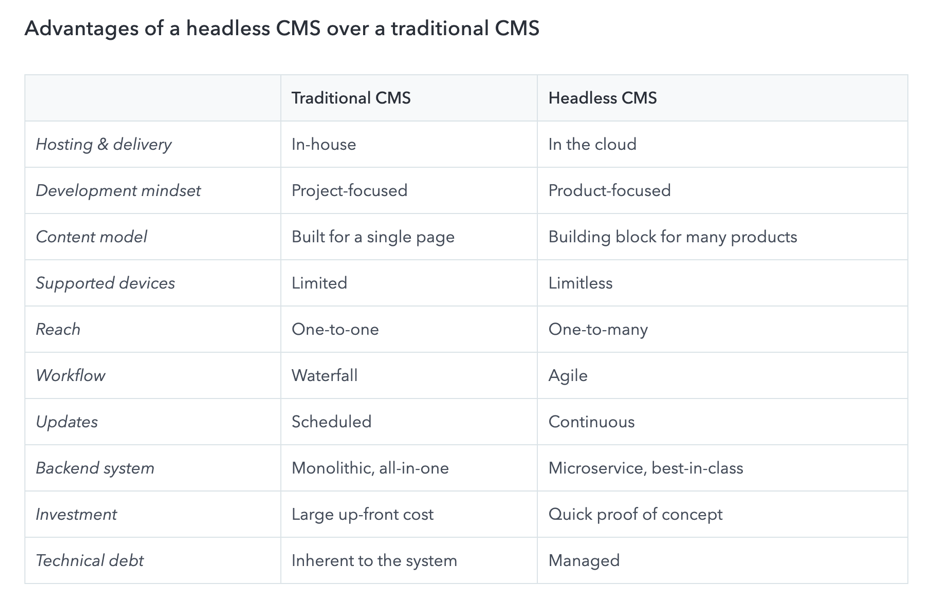The traditional content management system (CMS) is now frequently compared to headless CMS systems, as it gives enterprise marketers more freedom to deliver content faster through any digital channel or device.
A headless CMS is a content management system that decouples the backend infrastructure from the frontend presentation layer.
This allows developers to create digital experiences that are not limited by the capabilities of the CMS.
The headless CMS has picked up steam in the last year; many Fortune 500 companies have already adopted the technology.
Choosing the right system can be based on many factors, such as budget, type of business, needs, and deployment cases.
In this article, I will share insights into the advantages and disadvantages of both a traditional and a headless CMS.
First, let’s take a step back and explore the core reasons why a CMS is so important.
Content Management Systems (CMS)
In its most binary form, a CMS is software used to manage the creation and modification of digital content.
A CMS is often used for enterprise content management (ECM) and web content management (WCM). It usually has three main components: a content repository, a presentation layer, and a publishing workflow.
Content management systems are vital to the functioning of any website. They provide a clear structure for all your content, making it easy on visitors who might be looking for content via logical categories.
Put even more simply, a CMS typically provides two key features: a user interface for creating and editing content, and a set of tools for managing the content.
- For example, a CMS might allow users to add new pages to a website or edit existing pages. Additionally, a CMS might provide features such as search engine optimization (SEO) tools to help improve the visibility of website content.
- Many types of CMS software are available, ranging from simple systems installed on a single server to complex enterprise-level systems that support multiple users and sites.
When creating a website, many businesses find themselves in a catch-22 situation.
On the one hand, they want to make a sophisticated, feature-rich site that will wow potential customers and help them stand out from the competition.
But, on the other hand, they may not have the development resources on staff to build such a site from scratch.
The Traditional CMS: Ease Of Use But Lack Of Flexibility
When it comes to choosing a CMS, ease of use is often a top priority for companies that don’t have dedicated development resources.
Traditional CMS platforms like Drupal offer a simple, website-based experience that is perfect for creating basic websites. WordPress offers a similar experience, though it goes beyond a traditional CMS; it is possible to go headless with WordPress.
A traditional CMS can create a simple, user-friendly website for many organizations without investing in costly development resources.
In addition, traditional CMS platforms are often quite intuitive and easy to use, even for those with limited technical expertise. As a result, they provide an ideal solution for businesses that want to create a basic website without breaking the bank.
Traditional CMS is a choice for many deployment types, such as:
- If you’re looking to build your own personal website.
- Setting up a small business.
- You don’t need any kind of partnership beyond basic maintenance services from time to time.
A traditional CMS will set everything up quickly and allow you to manage sites through a single source interface. It can provide all necessary info about what goes where on each page while also offering essential SEO plugins.
It also has the advantage of:
- Being monolithic for ease of use.
- A vast array of templates and plugins, and content management tools.
- A large community of users.
Read More On SEJ
Digital Evolution And Content Velocity
Modern-day enterprises have surpassed digital transformation – a word of old.
That transformation has happened across all industries.
Now digital and content marketers are in a race to evolve and stay ahead of the competition. To do that, they need to find efficiencies to help them utilize resources to work faster and smarter.
In today’s fast-paced business world, scalability is essential for success. Organizations must adapt quickly to agile workflows and processes as they digitally evolve.
They need to do this to meet the demands of their customers and stay ahead of their competition.
However, if you rely on developers to make changes to your system, this growth will be significantly hindered. In addition, as your company expands, you’ll also be at increased risk of security breaches and data loss.
This is where a traditional CMS can lack the infrastructure to keep pace with the ever-changing digital landscape and the velocity of content that needs to be produced almost instantaneously.
Pre-built templates may offer little room for creativity. For SEO pros and content producers alike, this can hinder your ability to rank content in search engines and drive traffic to your website.
However, a CMS is not a ranking factor.
In many ways, the monolithic nature of a traditional CMS compromises ease of use with a lack of flexibility.
For these and all the above reasons, many large enterprise organizations are shifting to modern content management systems that offer better scalability, security, and speed.
Read More On SEJ
The Headless CMS: Managing Multiple Content Channels
A headless CMS provides the same ease of use as a traditional CMS but with the added flexibility of modern API-based architecture.
This type of architecture makes it easy to integrate your CMS with other software applications and services, giving you the power to deliver better-structured content and create complex digital experiences.
Headless CMS decouples the backend infrastructure from the frontend presentation layer. This allows developers to create digital experiences that are not limited by the capabilities of the CMS.
One of the key benefits of a headless CMS is that it enables organizations to deliver content to any channel or device. For example, a headless CMS can be used to power a website, a mobile app, and even a smartwatch app.
That gives organizations the flexibility to meet the needs of their customers across a wide range of channels.
Another benefit of a headless CMS is that it makes it easier to manage and update content. With a traditional CMS, each time something is changed on the backend, it must also be updated on the front end.
That can be time-consuming and frustrating for users. With a headless CMS, however, updates can be made directly on the backend without affecting the frontend experience.
For example, your front end is your website, and the back end is your content repository.
If you are creating an article in your content stack with a traditional CMS, you must wait for developers to update the front-end website look before publishing.
With a headless CMS, content is separated from your tech stack, allowing editors to collaborate on publishing more quickly and faster.
A great use case for a headless CMS is for ecommerce and Omnichannel marketers who need to quickly create in-the-moment (relevant) experiences and produce content for multiple consumer touch-points – making it much easier for organizations to keep their content up-to-date.
A headless CMS is suitable for deployments where:
- Speed is of importance, and bottlenecks are happening in development with marketing.
- A large content depository is needed.
- Omni-channel content is needed to be created and served with many CMS types.
- Website experiences need to be fast, real-time, and responsive.
- Enterprise security is a key priority.
- Large sites (ecommerce) with lots of content need to be managed.
 Image from author, September 2022
Image from author, September 2022Conclusion
Large enterprise organizations have many teams that they need to keep happy. In addition, they have many tools already working well in their tech stack.
Often, a traditional CMS can bundle together features that don’t need each other but add bloat to an application which can be difficult for developers. That’s especially true when creating or updating CMS.
In contrast, headless content management systems offer more speed and flexibility to deliver content across all the digital channels and new devices of today.
Choosing a CMS is a business decision that needs marketing, development, and IT input.
The solution you select depends on your type of business, the customers, and the audiences you want to serve content to.
More resources:
- Decoded Headless CMS & SEO
- CMS Market Share Trends: Top Content Management Systems In 2022
- Content Marketing: The Ultimate Beginner’s Guide to What Works
Featured Image: Cast Of Thousands/Shutterstock


